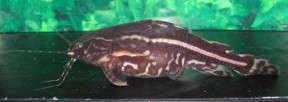Acanthodoras cataphractus
Chocolate Talking Catfish, Schokoladendornwels (DE)
SynonymsTop ↑
Silurus cataphractus Linnaeus, 1758; Cataphractus americanus Bloch & Schneider, 1801; Cataphractus americanus Lacepède, 1803; Doras blochii Valenciennes, 1840; Callichthys asper Gronow, 1854
Etymology
Acanthodoras: from the Greek ákantha (Gr. ἄκανθα), meaning ‘thorn,’ probably in reference to the presence of spines on the body of type species A. cataphractus, and Doras, the type genus of the family Doradidae.
cataphractus: from the Greek katáphraktos (Gr. κατάφρακτος), meaning ‘clad in armour’, in reference to any or all of the following characters: heavily ossified nuchal shield; bony spine-like posterior cleithral (humeral) process; sturdy and well-serrated pectoral-fin spines; deep, bony thorn-bearing plates along sides of body from tympanal region to caudal-fin base.
Classification
Order: Siluriformes Family: Doradidae
Distribution
Widespread throughout much of the northern Amazon basin in Bolivia, Brazil, Peru and Colombia plus Atlantic river drainages of Guyana, Suriname and French Guiana. The precise type locality is unknown since it was given only as ‘America’ in the original description.
Habitat
Slow-moving and standing waters including tributaries, backwaters, freshwater swamps and coastal mangroves where it’s typically found sheltering among roots or submerged vegetation during daylight hours before emerging at night to forage. It often occurs in large aggregations alongside other doradids such as Platydoras armatulus, Agamyxis pectinifrons, and Platydoras hancockii.
In the Iwokrama Forest, central Guyana it has been recorded to coexist with around 400 other species of which some available in the aquarium hobby include Anostomus anostomus, Hemigrammus belottii, H. ocellifer, Hyphessobrycon bentosi, H. rosaceus, Moenkhausia collettii, Pristella maxillaris, Carnegiella strigata, Hemiodus argenteus, H. gracilis, Nannostomus eques, N. marginatus, N. trifasciatus, Bunocephalus coracoideus, Callichthys callichthys, Corydoras melanistius, Megalechis thoracata, the congeneric Acanthodoras spinosissimus, Ancistrus hoplogenys, Hemiodontichthys acipenserinus, Hemiloricaria fallax, Apteronotus albifrons, Eigenmannia virescens, Biotodoma cupido, Geophagus brachybranchus, Pterophyllum scalare, Satanoperca jurupari, S. leucosticta and Colomesus asellus.
Maximum Standard Length
The largest officially-recorded specimen measured 115 mm.
Aquarium SizeTop ↑
Base dimensions of at least 120 cm x 30 cm are recommended.
Maintenance
Best maintained in a dimly-lit set-up with a soft, sandy substrate and plenty of cover in the form of aquatic vegetation, tangles of driftwood or artificial caves of some kind. Bright lighting isn’t really appreciated since this species is largely nocturnal by nature.
Water Conditions
Temperature: 22 – 26 °C
pH: 6.0 – 7.5
Hardness: 72 – 447 ppm
Diet
This species is an omnivorous generalist and will accept most commonly-encountered prepared and frozen foods. A varied diet comprising good quality, dried, sinking pellets or tablets supplemented by regular meals of live or frozen bloodworm, Tubifex, mosquito larvae, etc. is ideal, and the occasional whole or chopped earthworm will provide valuable additional protein.
Behaviour and CompatibilityTop ↑
Non-aggressive though adult individuals may consume very small fishes. It makes an excellent addition to a medium-to-large-sized community of Amazonian species alongside peaceful characins, cichlids and other catfishes, for example. It’s gregarious by nature so buy at least 4 specimens, and it will also group together with similarly-looking relatives such as Platydoras armatulus, Agamyxis pectinifrons, and Amblydoras hancockii.
Sexual Dimorphism
Mature females tend to be noticeably fuller-bodied than males.
Reproduction
Very little information seems to exist but apparently this species forms pair bonds with reports suggesting that both male and female are involved in excavating a shallow pit into which the eggs are deposited, plus post-spawning brood care and defence. Incubation is supposedly 4-5 days and it’s unclear whether parental care caesews
NotesTop ↑
This species, which may also be referred to by the alternative vernacular names ‘spiny catfish’, ‘painted talking catfish’ or ‘chocolate raphael’, isn’t particularly common in the trade and most often exported only as bycatch among shipments of Platydoras armatulus. It appears very similar to the congener A. spinosissimus with the most useful external distinguishing character being the presence of pale blotches on the dorsal surface, between the dorsal and caudal fins, in A. spinosissimus versus pale lines or no markings at all in A. cataphractus. Both species are sold under the same trade names.
Members of the family Doradidae can be distinguished from all other Siluriformes by possession of a unique infranuchal scute, a dermal bone consisting of an elongate plate formed by expansion of a ligament located between the posterior nuchal plate and the rib on the sixth vertebra. This feature is associated with the lateral line canal and represents the first in a series of prominent midlateral scutes exhibited by most doradids. There are two major lineages recognised within the family, one with simple barbels and a comparatively flattened head, the other with fimbriate barbels and a relatively deep head.
Within the order Siluriformes doradids are most closely related to the family Auchenipteridae, most commonly referred to as ‘driftwood’ catfishes by aquarists, and these two were grouped together in the superfamily Doradoidea by Sullivan et al. (2006). In their molecular phylogenetic analysis Doradoidea appeared to form a sister group pairing with the family Aspredinidae (banjo catfishes) with this constituting a significant departure from earlier hypotheses in which the African family Mochokidae and Asian Sisoridae were assumed to be most closely-associated with doradids and aspredinids, respectively. The authors stopped short of naming this putative Aspredinidae-Doradoidea clade, for the time being at least, ostensibly because certain prominent theories of fish biogeography would require substantial re-assessment if it were accepted.
Doradids are often referred to collectively as ‘talking catfishes’ in reference to the fact that many of them are able to produce audible sounds. In some genera (e.g. Acanthodoras, Agamyxis) these are produced via stridulation of the pectoral spines within their sockets, with the pelvic girdle possibly involved in projection of the resultant noise. The ‘elastic-spring apparatus’ is also used to produce sound, this comprising a highly-specialised arrangement of the parapophyses of the fourth vertebrae, the swim bladder plus associated muscles and ligaments.
Take care when netting doradids for any reason since the pectoral fin spines and body scutes easily become entangled in the mesh of standard aquarium nets and can break human skin in many cases.


